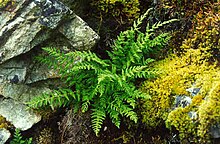Physematium scopulinum
| Physematium scopulinum | |
|---|---|

| |
| Scientific classification | |
| Kingdom: | Plantae |
| Clade: | Tracheophytes |
| Division: | Polypodiophyta |
| Class: | Polypodiopsida |
| Order: | Polypodiales |
| Suborder: | Aspleniineae |
| Family: | Woodsiaceae |
| Genus: | Physematium |
| Species: | P. scopulinum |
| Binomial name | |
| Physematium scopulinum | |
| Synonyms[2] | |
| |
Physematium scopulinum, also called Woodsia scopulina, is a deciduous perennial fern in the family Woodsiaceae, with the common name Rocky Mountain woodsia.
This plant is native to the western and northern United States and Canada. W. scopulina is a small to medium sized fern, 10-30 centimeters high, which grows in mesic to dry rock crevices.[3][4]
Description
Physematium scopulinum has twice pinnate fronds arising from a short scaly rhizome. The mostly upright fronds are 10–30 cm in length and up to 8 cm in width and are medium to pale green in color. The pinnae and rachis are sparsely to moderately covered with long hairs that protrude sharply (not appressed to stem), some with a globular gland at the tip. The hairy rachis distinguishes it from the similar species Physematium oreganum. The rachis is grooved on top (adaxially). Small round sori on the underside of pinnae are initially partly covered with a narrowly lobed indusium. New leaves show circinate vernation (tightly curled).[5]
Range
Physematium scopulinum is widespread in mountains near the west coast of North America from southern Alaska to southern California, and in the Rocky Mountains from British Columbia to Colorado. There are also isolated populations in northeastern North America.[5]
Habitat
Physematium scopulinum is commonly found in sunny rocky habitats including rock crevices, talus slopes, and rock ledges.[4]
Gallery
- Leafing out in spring
- Growing among talus rock
- Underside of leaf
References
- ^ NatureServe (November 1, 2024). "Woodsia scopulina". NatureServe Explorer. Arlington, Virginia. Retrieved November 17, 2024.
- ^ Hassler, Michael. "Physematium scopulinum". World Ferns. Retrieved 13 June 2023.
- ^ Dale H. Witt, Janet E. Marsh, and Robin B. Bovey, Mosses Lichens and Ferns of Northwest North America (Edmonton: Lone Pine, 1988), p. 273
- ^ a b Burke Herbarium Image Collection, Chaenactis thompsonii
- ^ a b Hitchcock, C. Leo; Cronquist, Arthur (2018). Giblin, David; Legler, Ben; Zika, Peter F.; Olmstead, Richard G. (eds.). Flora of the Pacific Northwest (Second ed.). Seattle, Washington: University of Washington Press. p. 60. ISBN 9780295742885. OCLC 1027726040.
External links
- Jepson Manual Treatment
- USDA Plants Profile
- Flora of North America
- Washington Burke Museum
- Photo gallery




